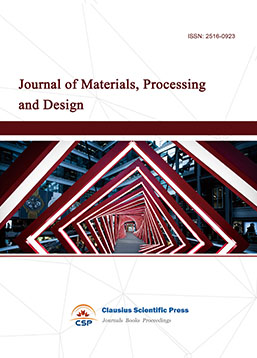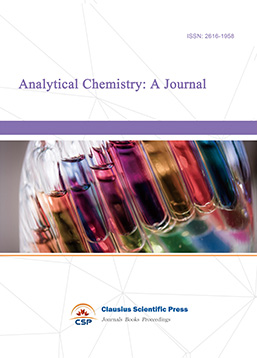Advances in Synthesis, Structure and Structure-Activity Relationship of Lead Complexes Containing Nitrogen and Oxyheterocyclic Compounds
DOI: 10.23977/mpcr.2022.020102 | Downloads: 10 | Views: 1629
Author(s)
Xiaoguang Wang 1, Hongda Ma 1, Yueyun Yang 1
Affiliation(s)
1 School of Chemistry and Chemical Engineering, Zhoukou Normal University, Zhoukou, Henan, 466001, China
Corresponding Author
Xiaoguang WangABSTRACT
Metal carboxylate coordination compounds with polydentate ligands containing nitrogen and oxygen donors has been greatly developed in the past decade, especially for the coordination polymers with the transition metal. However, the coordination polymers of main group elements, especially for the Pb (II) of such compounds is scarcely reported. In this paper, the supramolecular action of complexes, the development status of lead compounds, luminescent complexes and their mechanism, the transformation of single crystal structure and the progress are reviewed.
KEYWORDS
Nitrogen-oxygen polydentate ligand, Supramolecular action, Lead (II) complex, Single crystal structureCITE THIS PAPER
Xiaoguang Wang, Hongda Ma, Yueyun Yang, Advances in Synthesis, Structure and Structure-Activity Relationship of Lead Complexes Containing Nitrogen and Oxyheterocyclic Compounds. Modern Physical Chemistry Research (2022) Vol. 2: 11-17. DOI: http://dx.doi.org/10.23977/mpcr.2022.020102.
REFERENCES
[1] Wei Chen, Hong-Ming Yuan,Jia-Yu Wang, etc. (2003) Synthesis, Structure, and Photoelectronic Effects of a Uranium-Zinc-Organic Coordination Polymer Containing Infinite Metal Oxide Sheets. Journal of the American Chemical Society. 125, 31. 9266-9267.
[2] Ye, B. H. Tong, M. L. Chen, X. M. (2005) Metal-organic molecular architectures with 2, 2prime-bipyridyl-like and carboxylate ligands. Coordination chemistry reviews. 249, 5. 545-565.
[3] Li G. Fan YT. Hou HW. (2003) Novel Pb (II), Zn (II), and Cd (II) coordination polymers constructed from ferrocenyl-substituted carboxylate and bipyridine-based ligands. Inorganic Chemistry: A Research Journal that Includes Bioinorganic, Catalytic, Organometallic, Solid-State, and Synthetic Chemistry & Reaction Dynamics. 42, 16.
[4] Chang-Tong Yang, Keith S. Murray, Boujemaa Moubaraki. (2003) Synthesis, characterization and properties of ternary copper (II) complexes containing reduced Schiff base N-(2-hydroxybenzyl)-alpha-amino acids and 1,10-phenanthroline. Dalton transactions: An international journal of inorganic chemistry. 5.
[5] Mahjoub AR. Morsali A. (2002) Direct synthesis of a dimeric mixed-anion lead (II) complex, crystal structure of [Pb (phen) (2OCCH3) (NCS)] (2). Polyhedron: The International Journal for Inorganic & Organometallic Chemistry. 21, 12.
[6] Esteban D. Platas-Iglesias C. (2002) Mahia J. Lead (II) complexes with macrocyclic receptors derived from 4,13-diaza-18-crown-6. Inorganic Chemistry: A Research Journal that Includes Bioinorganic, Catalytic, Organometallic, Solid-State, and Synthetic Chemistry & Reaction Dynamics. 41, 17.
[7] Jonathan Parr. (1997) Some recent coordination chemistry of lead (II). Polyhedron. 16, 4, 551-566.
[8] Robert Luckay. (1997) Synthesis, stability and structure of the complex ofbismuth (III) with the nitrogen-donor macrocycle1,4,7,10-tetraazacyclododecane. The role of the lone pair onbismuth (III) and lead (II) in determiningco-ordination geometry. Dalton Transactions. 5, 901-908.
[9] Blasse G. Zuidema J. Folkerts HF. (1996) Different Types of S (2) Ion Luminescence in Compounds with Eulytite Structure. Chemical Physics Letters. 249, 1.
[10] A.M. van de Craats, G. Blasse. (1996) The influence of d10 ions on the luminescence of bismuth (III) in solids. Materials Research Bulletin. 31, 4. 381-387.
[11] Karl Wieghardt, Wolfgang Walz, Bernhard Nuber. (1986) Crystal structure of bis[bis(1,4,7-triazacyclononane) nickel (III)] dithionate heptahydrate and its single-crystal EPR spectrum. Inorganic Chemistry. 25, 10, 1650-1654.
[12] KONG Zhi-guo, Wang Wei, ZHANG Bing. (2015) Synthesis, Crystal Structure and Luminescence of a New Two-dimensional Pb (Ⅱ) Coordination Polymer. Structural chemistry. 10.
[13] WANG Xiu-yan, LIU Fu-Yi, ZHANG Yan-na, etc. (2014) A New Cadmium(Ⅱ) Coordination Polymer Constructed by 2-(2-Chloro-6-fluorophenyl)-1H-imidazo[4,5-f] [1,10] phenanthroline and 1,2,3-Benzenecarboxylate: Synthesis, Structure and Luminescence. Structural chemistry, 3.
[14] WANG Xiu-yan, LIU Fu-Yi, ZHANG Yan-na, etc. (2014) Synthesis, Crystal Structure and Photoluminescence of a New Zn(Ⅱ) Dimer Constructed by 1,10-Phenanthroline Derivative and Flexible Dicarboxylate. Structural chemistry, 1.
[15] Shiota, Y. Ishizuka, T. Sawaki, T. etc. (2013) Complete photochromic structural changes in ruthenium (II)-diimine complexes, based on control of the excited states by metalation. Chemistry: A European journal, 19, 27.
[16] O. Keeffe, M. Yaghi, O. M. (2012) Deconstructing the crystal structures of metal-organic frameworks and related materials into their underlying nets. Chemical Reviews. 112, 2.
[17] Chen JS, Cao JJ, Li GD, etc. (2007) Structural variation from 1D to 3D: Effects of ligands and solvents on the construction of lead (II)-organic coordination polymers. Chemistry: A European journal, 13, 11.
[18] Rosenberg JM, Bryan JC, Kavallieratos K. (2005) Pb (II) coordination and synergistic ion-exchange extraction by combinations of sulfonamide chelates and 2,2 '-bipyridine. Inorganic Chemistry: A Research Journal that Includes Bioinorganic, Catalytic, Organometallic, Solid-State, and Synthetic Chemistry & Reaction Dynamics, 44, 8.
| Downloads: | 960 |
|---|---|
| Visits: | 60699 |
Sponsors, Associates, and Links
-
Forging and Forming

-
Composites and Nano Engineering

-
Journal of Materials, Processing and Design

-
Metallic foams

-
Smart Structures, Materials and Systems

-
Chemistry and Physics of Polymers

-
Analytical Chemistry: A Journal

-
Inorganic Chemistry: A Journal

-
Organic Chemistry: A Journal

-
Progress in Materials Chemistry and Physics

-
Transactions on Industrial Catalysis

-
Fuels and Combustion

-
Casting, Welding and Solidification

-
Journal of Membrane Technology

-
Journal of Heat Treatment and Surface Engineering

-
Trends in Biochemical Engineering

-
Ceramic and Glass Technology

-
Transactions on Metals and Alloys

-
High Performance Structures and Materials

-
Rheology Letters

-
Plasticity Frontiers

-
Corrosion and Wear of Materials

-
Fluids, Heat and Mass Transfer

-
International Journal of Geochemistry

-
Diamond and Carbon Materials

-
Advances in Magnetism and Magnetic Materials

-
Advances in Fuel Cell

-
Journal of Biomaterials and Biomechanics


 Download as PDF
Download as PDF